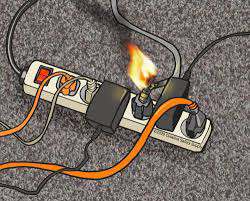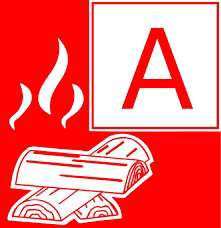SAFETY PRECAUTION:The students working with electricity should try to save themselves from the electric shocks. Accidents cannot happen on its own rather there are certain reasons behind them. So following precautions should be taken while working with the electricity as per IS-5216 General safety.
 |
| SAFETY |
1.Never wear loose clothes while working in the workshop.
2. The electric shocks are usually received and can easily be avoided by being careful.
3. -A great care should be taken against electric shock while working on the line whether its conductor is insulated or bared
4. Never work bare feet. It is better to wear rubber shoes while working.
5.In case of electric shock when a victim is still in contact with the live wire, which you cannot immediately switch off,. insulate yourself on a dry wood or any other insulating material to release the victim.
-6. Use safety belt before starting the work on an electric pole or tower.
7. The ladder should always be held by another person while working on overhead lines, so that it may not slip away.
8. Phase or positive wire should always be connected through the switch.
9.Before energising the line, check that there is none working on the main line.
10. Before replacing the blown fuse, always keep the main switch off.
11. Before taking a table fan or any portable appliances from one place to another, disconnect
12. Do not disconnect the flexible wire of an electrical equipment from the socket by pulling it out.
13.. Before starting the work, be ensured that you are authorised to do the work.
14. Do not tamper electrical protective or interlocking gear unless you are authorised. These devices are meant for your safety.
The following precautions to be followed while working : 1. Working on the overhead line:
(a) A safety belt must be used.
(b) Use insulated tools and rubber gloves while working on the live line.
(e) Before starting the job on the dead line, all the wires of the line should be short by the iron chain.
(d) After switching off the main supply, a notice should be displayed written in the regional language that men are at work.
(e) If necessary, one person should sit near the main switch.
2. Working on a ladder :
(a) The ladder should he of proper height.
(b) The ladder should be firmly held by a helper.
3. Replacing a blown fuse:
 |
| Blown fuse |
(a) Before replacing a blown fuse, switch off the main supply first.
(b) Open the cover of the main switch, take out the fuse grip and try to know the reason of blowing of the fuse.
 |
| Check the fuse |
(c) Replace the fuse with proper fuse wire.
(d) Put the fuse grip properly in the main switch and close the cover.
(e) Now stand on one side of the main switch and then put the handle on.
4. In case of fire:
(a) Put the main switch off immediately.
(b) Never throw water to extinguish the fire.
(c) Throw dry dust or sand to extinguish the fire
. (d) Use fire extinguisher to extinguish the fire.
(e) Before using it make sure that it is of carbon dioxide type.
5. Preparing the electrolyte and battery charging:
(a) The battery charging room should be well dry and airy.
(b) The acid should be gently poured into the water and not water into acid.
(c) Pour acid drop by drop from the side of the container to over come the endothermic reaction.
(d)pour acid drop by drop from the side of the container to over come the endothermic reaction
Fire Extinguishing :
All workshops and offices should have approved fire extinguishing apparatus, so that fire caused by electricity or any other reason can be easily extinguished. Fire can put life of people working in workshop and offices in danger and can also damage the property. These apparatus should be installed at places from where it is easily accessable. Apart from them buckets of water and stand etc. should also be available.
Fire Extinguishers :
It is a type of device through which fire is extinguished by cutting of the oxygen supply to the burning object. This device contains liquid, gas and some mixture which does not burn and nor helps in burning. This device is of following types and helps in extinguishing fire caused by different reasons.
1. Foam Type Fire Extinguishers:
Oil, soap etc. mixed with water is filled in this apparatus through air pressure, when lever is pressed, water in a mixture form cuts of the oxygen supply to the burning object and extinguishes the fire. This type of fire extinguisher is used for extinguishing fire caused by diesel, kerosene, petroleum, etc.
2. Water Filled Type Fire Extinguisher :
Water through air pressure is filled in this type of apparatus, when lever is pressed it sprinkles water through which fire is extinguished. It is suitable for extinguishing fire caused by wood, cloth, jute, paper, etc.
3. Carbon Dioxide Type Fire Extinguisher :
This type of extinguisher is used for extinguishing electrical fires. It contains sodium bicarbonate (NaHCO,) and a glass flask containing sulphuric acid (dil. H₂SO).
The glass flask has a bolt at the top which breaks the glass flask when the extinguisher is inverted. This causes sulphuric acid to react with sodium bicarbonate to generate carbon dioxide which extinguishes the electrical fire.
2NaHCO,+ H₂SO,→→ Na,SO, + 2H₂O+2CO₂
Note: Fire has been divided into four categories:
NOTE: fire has been derive into your category
1. Class 'A': This category contains fire due to wood, paper, cloth, etc. Oil and water should be used to extinguish the fire caused by them.
2. Class 'B': This category contains liquids which melt on heating. Water should never be used on them. To extinguish fire, foam or carbon dioxide or dry powder should be used.
3. Class 'C': This category contains fire caused by gas or liquid gas. Dry powder based fire extinguisher should be used in this category.
4. Class 'D': This category contains fire caused by electrical appliances. Carbon dioxide, dry powder, carbon tetrachloride based fire extinguishers should be used in this case.
Electric shock is sudden or unexpected. When a current passes through the body, it stimulates the body's nervous system depending upon its intensity i.e., if it of low intensity, the victim is easily release but if it is of high intensity then victim may not release himself from the supply. If someone else touches this victim in order to save him then that person will also get a shock if not properly trained.
Severity of Shock: The severity of shock depend on :
1. Nature of supply i.e., A.C. or D.C.
2. Electric pressure i.e., voltage
3. Weather condition 4. Contact area of the body with supply wire/appliance etc.
5. Duration of contact
6. Mental stress at the time of accident
7. A.C. more dangerous than D.C.























Post a Comment